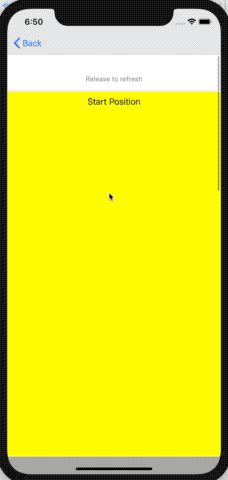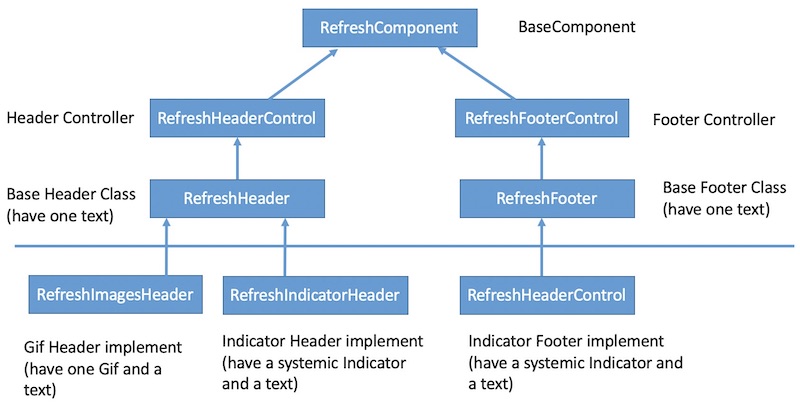FigRefresh is a Swift refresh framework. It's api looks like MJRefresh. FigRefresh is simple and extensibility.
import FigRefresh
scrollView.fig_header = RefreshIndicatorHeader(refreshingClosure: { [weak self] in
DispatchQueue.global().async {
sleep(3)
DispatchQueue.main.async {
self?.scrollView.fig_header?.endRefreshing()
}
}
})look up FigRefreshDemo project in sources.
RefreshComponent have a titleLabel property,it use show different text on various states. I suggest you custom titleLabel in it's sub classes.
I support 3 types implements:
- 1、Text.
- 2、Indicator + Text.
- 3、Images + Text.
If these can't satisfy you,Just inherit RefreshHeader and RefreshFooter class.
public class MyCustomHeader:RefreshHeader{
//Custom UI
var myImage:UIImageView?
var myDetailsLabel:UILabel?
...
//Return height of UI. 50 is default value
public override func refreshComponentHeight() -> CGFloat {
return 50
}
//Just excute once. This method used to init UI.
public override func refreshComponentDidMoveToSuperview() {
//must call
super.refreshComponentDidMoveToSuperview()
//Custom styles of myImage
//Add myImage
addSubview(myImage)
//Layout myImage
...
//Custom styles of myDetailsLabel
//Add myDetailsLabel
addSubview(myDetailsLabel)
//Layout myDetailsLabel
...
//If you meed custom titleLabel
titleLabel?.textColor = UIColor.gray
titleLabel?.textAlignment = .left
titleLabel!.font = UIFont.systemFont(ofSize: 13)
//Option1: Layout titleLabel use constraints
// titleLabel?.snp.remakeConstraints({ (make) in
// make.left.equalTo(animationIV.snp.right).offset(10)
// make.centerY.equalToSuperview()
// make.height.equalToSuperview()
// make.right.equalToSuperview()
// })
//Option2: Layout titleLabel use frame
titleLabel?.frame = CGRect(x: animationIV.frame.maxX + 10, y: 0, width: frame.width - (animationIV.frame.maxX + 10), height: height)
...
}
public override func refreshComponentStateChange(state: RefreshState) {
super.refreshComponentStateChange(state: state)
switch state{
case .refreshing: //custom style on refreshing state
...
break
default: //custom style on idle state
...
break
}
}
}FigRefresh have 6 states:
- idle: normal idel
- pullingInRect: pulling and component not displays fully
- pullingOutRect: pulling and component displays fully
- releaseing: Releaseing, not refreshing, from pullingInRect state.
- refreshing: Releaseing, and refreshing, from pullingOutRect state.
- noMoreData: no more date(only footer)
RefreshHeader and RefreshFooter classes,support default text on states:
open class RefreshHeader:RefreshHeaderControl{
...
open override func refreshComponentTitlesWithStates() -> [RefreshState : String] {
return [.idle:"Pull down to refresh",
.pullingInRect:"Pull down to refresh",
.pullingOutRect:"Release to refresh",
.releaseing:"Pull down to refresh",
.refreshing:"Loading..."]
}
}open class RefreshFooter:RefreshFooterControl{
...
open override func refreshComponentTitlesWithStates() -> [RefreshState : String] {
return [.idle: "Pull up to load more",
.pullingInRect: "Pull up to load more",
.pullingOutRect: "Release to load more",
.releaseing:"Pull up to load more",
.refreshing:"Loading...",
.noMoreData:"No more data"]
}
}
- 1、Add new proterties.
- 1、Override refreshComponentTitlesWithStates method to custom text.
- 2、Override refreshComponentDidMoveToSuperview method to custom UI.
Set onec Header and Footer.
FigRefreshSetDefaultHeader(MyCustomRefreshHeader.self)
FigRefreshSetDefaultFooter(MyCustomRefreshFooter.self)
call header use fig_header. call footer use fig_footer.
scrollView.fig_header {
DispatchQueue.global().async { [weak self] in
sleep(3)
DispatchQueue.main.async {
self?.scrollView.fig_header?.endRefreshing()
}
}
}
scrollView.fig_footer { [weak self] in
DispatchQueue.global().async {
sleep(3)
DispatchQueue.main.async {
self?.scrollView.fig_footer?.endRefreshing()
}
}
}tableView.fig_footer?.setTitle("xxxx", for: .noMoreData) // If needed.
tableView.fig_footer?.endRefreshingWithNoMoreData() scrollView.fig_header = MyCustom2Header(refreshingClosure: { [weak self] in
DispatchQueue.global().async {
sleep(3)
DispatchQueue.main.async {
self?.scrollView.fig_header?.endRefreshing()
}
}
})- iOS 8.0+
- Xcode 10.2
- Swift 5
Add the following line to your Podfile:
pod "FigRefresh"Kevin Zhou
- 邮件: wumingapie@gmail.com
- Twitter: @wumingapie
- Facebook: wumingapie
- LinkedIn: Rafael
FigRefresh is available under the MIT license. See the LICENSE file for more info.




